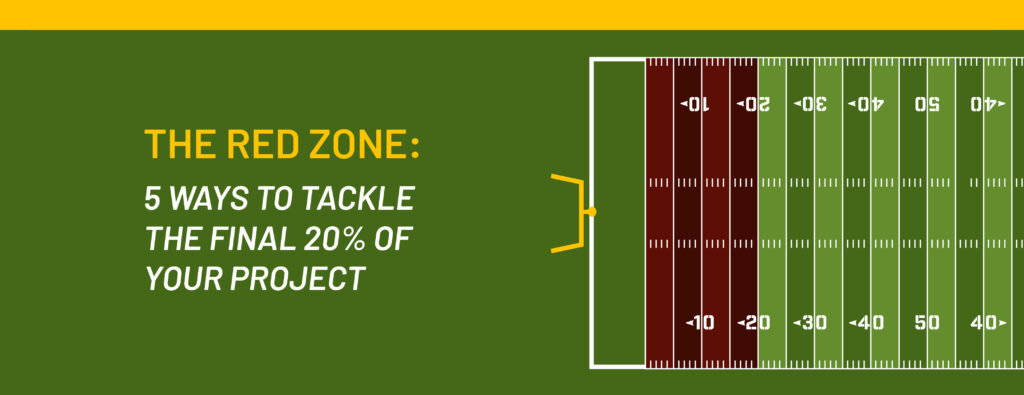 The clock’s winding down, the pressure’s on, and you’re charging toward the goal line, just 20 yards from the finish. In football, this is the Red Zone, where the stakes are at their highest. Each move counts, and the most challenging part of the game is still ahead. One wrong play could cost you the win.
The clock’s winding down, the pressure’s on, and you’re charging toward the goal line, just 20 yards from the finish. In football, this is the Red Zone, where the stakes are at their highest. Each move counts, and the most challenging part of the game is still ahead. One wrong play could cost you the win.
In construction, the Red Zone is just as intense. It’s the final 20% of your project, where everything is coming together, but the risks are higher than ever. Deadlines are closing in, quality is under the microscope, and the building occupants are anxious to complete the construction so they can furnish the space and move in. This is the moment when your team has the best opportunity to cross the finish line successfully, but it’s also where small setbacks can turn into significant delays.
In this blog, I’d like to offer five proven strategies to help your team plan for the Red Zone and get through the toughest part of any capital project to finish strong.
What Exactly Is the Red Zone in Construction?
In construction, the Red Zone refers to the final phase of a project, typically starting when a project is roughly 75% to 80% complete, and lasting until the final handoff to building operations. Much like in football, the Red Zone in construction signifies the last stretch where everything needs to come together, but at a time in the project when there’s little margin for error. The pressure to deliver on time, meet regulatory standards, and verify the operation of multiple building systems is at its peak.
The Red Zone process was first introduced by the U.S. Army Corps of Engineers (USACE) in 2002, primarily to address the challenges around closing out military construction projects. Naval Facilities Engineering Systems Command (NAVFAC) adopted this process to achieve the successful transition from construction to operations of new and renovated facilities. The approach has proven highly effective and has since been adopted by other federal agencies, eventually expanding into the non-federal sectors. Through a process of early preparation, clear communication, planned acceptance testing, and defined responsibilities, projects can make a successful transition from construction to operations.
Why Is the Red Zone So Challenging?
The Red Zone is particularly tough because while the project is nearing completion, the most critical and complex tasks still lie ahead. These include:
- Punchlist Completion: Punchlists are often long lists of small tasks that require close coordination across multiple trades. Punchlist work is often performed in nearly complete spaces and must be protected from damage to installed work. In addition, balancing completion of punchlist tasks with installation of any other remaining work can become a logistical challenge, especially as these tasks often must be completed concurrently. The sheer volume of tasks can overwhelm even the best teams if not systematically tracked.
- Commissioning and System Testing: Building systems, including HVAC, electrical, plumbing, fire protection, life safety, and the building envelope, should be thoroughly tested and verified for operation and performance. Before the project is complete, all systems must meet regulatory standards and perform as expected. Testing requires precise coordination between various parties, and delays in testing or failing to meet specifications could delay the entire turnover process. Because of the complexity of the systems, commissioning involves multiple subject matter experts coordinating efforts to verify systems in accordance with the basis of design for the project.
- System Validation and Acceptance: Once systems are commissioned, critical HVAC and electrical systems may undergo additional acceptance testing to verify that equipment operates at full capacity in seasonal conditions to meet performance specifications over a period of time. This phase can be time-consuming and requires close collaboration with contractors, consultants, and clients. Verifying systems pass validation and performance requirements requires rigorous testing and oversight, with often tight timelines in parallel with occupant move-in activities that add to the stress.
- Move-in Sequencing, Coordination, and Closeout: The final task in the Red Zone is preparing the space for occupancy. This includes coordinating logistics for FF&E delivery and installation, move-in sequencing, and making any last-minute adjustments to spaces or systems. Contract requirements for closeout including final inspections with the authority having jurisdiction (AHJ), preparation of as-built documentation, submission of O&M manuals and product warranties, training of the operations and maintenance personnel, and establishing the beneficial occupancy date must all be completed. Proper coordination is essential to verify that everything is ready for scheduled move-ins. Many times, this step overlaps with the completion of punchlist, commissioning, validation, and acceptance activities, which means that many different parties are working within the facility at the same time.
5 Key Strategies for Successfully Navigating the Red Zone
Despite the challenges the Red Zone poses, there are ways to manage the complexity and deliver project success. Here are five proven strategies teams should add to their playbook to achieve a successful closeout:
1. Start Early
It may seem intuitive to wait until the final project stages to focus on punchlist, commissioning, testing, system validation, and move-in activities, but starting early, setting common expectations (and documenting them in the Project Management Plan), integrating the Red Zone process into a project’s master schedule, and identifying team members responsible for completing these activities can prevent delays. Successful teams begin developing their Red Zone playbook early in the construction phase to have a defined plan. They also identify team members responsible for tracking and addressing issues before they escalate, reducing the likelihood of delays caused by testing failures, last-minute punchlist items, or incomplete documentation.
2. Use Structured Tools for Tracking and Accountability
The Red Zone will necessarily involve many tasks that need to be completed simultaneously. Tools like NAVFAC’s Red Zone (NRZ) Checklist help teams plan and track activities and assign responsibilities, making monitoring progress easier, so no task is overlooked. Using other structured tools available within a shared project management information system (PMIS) platform to track assigned actions, systems testing, punchlist completion, and final inspections can verify that Red Zone tasks are completed on time, minimizing the risk of missed deadlines or incomplete work. Organizing tasks by responsible party will also keep the process moving efficiently and help prevent bottlenecks.
3. Establish Communication Protocols
Because so many parties are involved in Red Zone work and project completion, communication must be clear and continuous. Communication should come in the form of progress updates and shared schedule information that are accessible to all project team members and reviewed in weekly meetings and check-in discussions. The project team must have established communication channels and real-time updates so they can identify potential roadblocks and develop mitigation strategies. When communication breaks down, issues can quickly derail the project.
4. Prioritize Quality
During the Red Zone, teams are often pressured to rush through tasks to meet deadlines. However, achieving schedule milestones shouldn’t be at the expense of delivering quality. There is no more important time for collaboration between quality assurance (QA) and quality control (QC) teams than the Red Zone. The project team should adhere to the protocols established in the project’s quality management plan, even in the Red Zone. This means punchlist, commissioning, and acceptance activities have the same quality expectations as were in place during the height of the construction phase. Rushing through testing or disregarding quality management requirements can lead to missed issues, especially with complex systems like HVAC, electrical, building envelope, and other integrated systems, which subsequently result in schedule delays, additional costs, and operational issues well after project completion.
5. Prepare for the Unexpected
Despite careful planning, unforeseen challenges will always arise during the Red Zone. Flexibility is essential, whether it’s unexpected punchlist issues, testing delays, or last-minute system adjustments to meet a changed owner’s requirement. Identifying potential risks, developing mitigation and contingency plans, and allocating backup resources can help the team prepare for the unexpected. The ability to adjust priorities or shift resources to address new issues can help prevent these challenges from derailing the entire closeout process.
As we enter football season and watch teams battle through the Red Zone, it’s a reminder of the importance of the final push. By using the Red Zone methodology, teams can plan and implement tools in their playbook to execute the final phases of construction and project turnover efficiently, maintain quality, and deliver a project ready for occupancy on time. Ultimately, it’s about crossing the finish line with a win.
Download a copy of this blog here.




